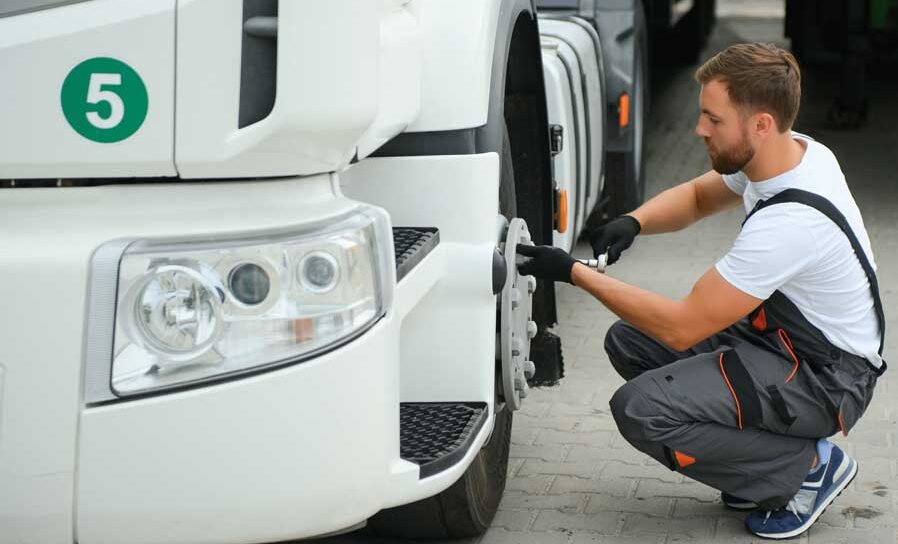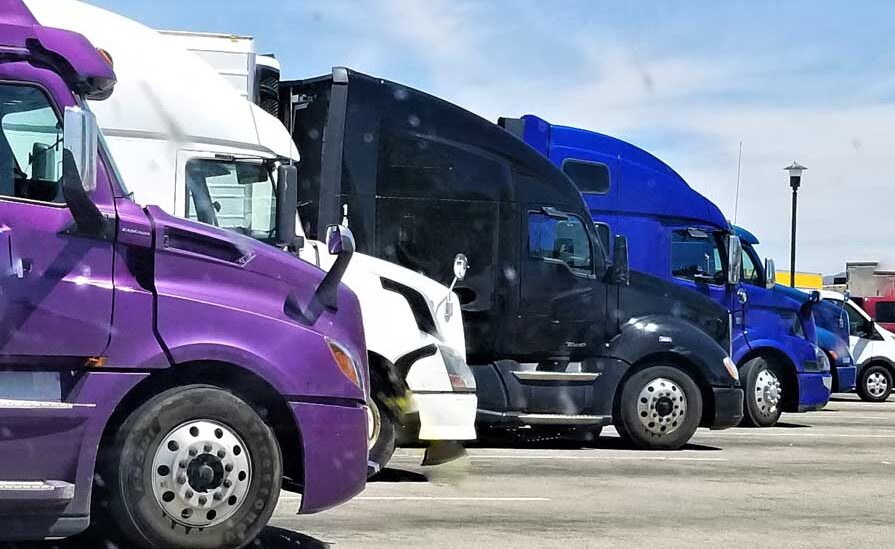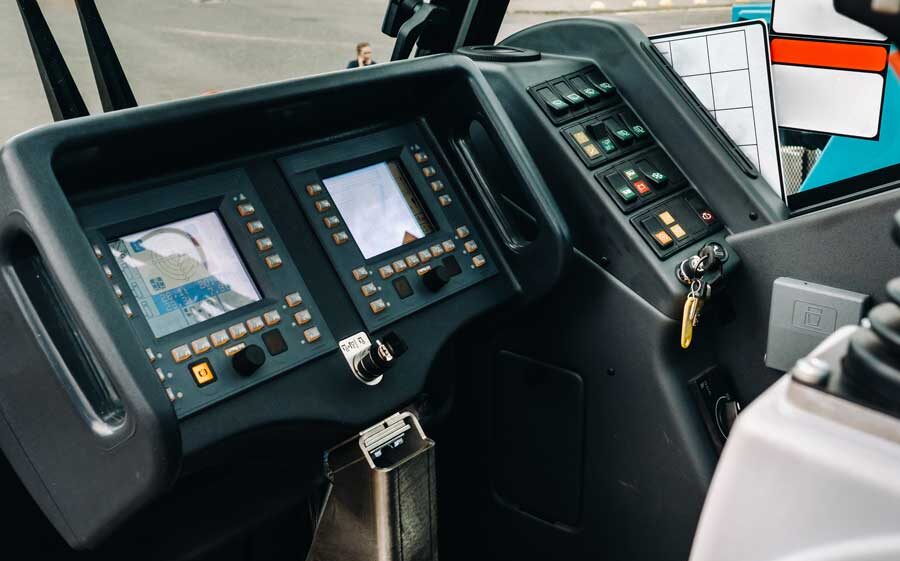Key Takeaways:
- Each driver must use a unique login to guarantee their hours are recorded separately. Shared logins are prohibited to maintain data integrity. Drivers should be trained on proper login procedures to avoid violations.
- Duty status changes must be accurately recorded and verified during log transfers. This guarantees that each driver’s record is complete and avoids data overlap. A clean handoff between shifts is essential.
- ELDs must track driving time and rest periods for compliance with FMCSA regulations. In split-duty situations, accurate logging is critical to avoid violations and prevent drivers from being disqualified.
- Troubleshooting login issues and data entry errors helps minimize disruptions and maintain accurate records. Timely resolution of issues is necessary to guarantee the ELD system functions reliably and stays compliant.
- Advancements like biometric authentication and automated data transfer will improve accuracy and streamline compliance. These developments will make ELD systems more efficient and easier to use for team driving.
Table of Contents
Maximize Compliance with Two Drivers Using the Same ELD
Team driving remains a standard practice in long-haul freight. The Federal Motor Carrier Safety Administration (FMCSA) estimates that over 20% of freight is handled by two-driver teams operating under the same duty cycle. Fleets adopt shared operations to extend driving hours legally and improve transit efficiency. Two drivers same ELD introduce compliance challenges that require strict attention to detail. Regulations demand accurate electronic records for each operator during every shift change.
Each driver must use a separate login and maintain distinct activity logs. According to the FMCSA, failure to follow proper ELD sharing procedures contributes to 15% of form and manner violations discovered during audits. Incorrect or overlapping logs compromise driver identification and may lead to enforcement penalties. The ELD system must track individual time, driving status, and rest periods without confusion or shared credentials.
Understanding the rules behind shared ELD use protects fleets and drivers. The following sections explain how to manage separate driver accounts and follow compliant login procedures. Readers will learn how to reduce errors and avoid violations tied to misuse of a shared logging system.
Maintain Compliance with Proper Driver Identification and ELD Logins
Driver identification guarantees that every action recorded by the ELD reflects the correct operator. Federal law requires each driver to use unique driver accounts tied to personal credentials. Shared logins violate FMCSA rules and undermine data accuracy. Every driving session, duty change, and vehicle movement must match the driver’s profile. According to FMCSA data, log violations involving incorrect driver assignments are among the top five reasons for audit failures.
Each driver must log in and out independently. The incoming operator must confirm that the previous user has logged out before taking control. The ELD system must update duty status to reflect the new driver before the vehicle moves. Manual confirmation of these steps improves log continuity. Failure to follow correct login procedures can result in dual log entries, time overlaps, or incomplete records. These issues can lead to penalties or forced off-duty orders during inspections.
Shared credentials are not allowed under any circumstance. Each user must protect their account and avoid giving access to others. Misuse of driver accounts creates confusion, disrupts data integrity, and increases the risk of noncompliance. Fleets should train drivers to follow login protocols and schedule internal audits to verify proper use. Accurate driver identification supports legal driving hours, builds accountability, and protects the business during enforcement reviews.

Manage Logbook Transfers and Maintain Clear Data Separation
Accurate logbook transfer procedures support compliance and prevent confusion when multiple drivers use the same ELD. Each driver must record duty status changes at the beginning and end of every shift. One driver must select the appropriate duty status such as “off-duty” or “sleeper berth” at the end of the session. The next driver must log in before operating the vehicle and confirm the change to “on-duty” or “driving.” Every entry must reflect the correct activity and time stamp to guarantee accuracy in case of inspection or audit.
The logbook transfer process begins when the current driver logs out. The ELD system preserves the recorded data and prepares it for reassignment. The next driver logs in and reviews the previous entries for continuity. Most best ELDs for team driving support automated detection of driver changes based on login activity and sensor input.
The system isolates the previous session and creates a new record for the incoming driver. This process maintains data separation, which is required under FMCSA regulations. Mixing logs between drivers can lead to HOS violations, mismatched hours, and enforcement penalties.
Verification of the logbook transfer is essential. Every driver must confirm that the system correctly applied the log changes before driving resumes. Reviewing the log screen and making sure the correct driver is assigned prevents errors. Fleet managers should train drivers to review status logs after every switch. Discrepancies between vehicle movement and driver assignment may trigger roadside inspection issues. Each entry must be traceable to an individual account, making sure of accountability and accurate tracking of duty hours.
Avoid Data Overlap Through Clear Status Management
Drivers must check for unassigned driving segments before logging in. Any gaps or overlaps between sessions may indicate a mismanaged transfer. The ELD must show a clean handoff between duty periods. Drivers should not begin operation until the previous status is finalized. This step avoids shared entries that violate data separation requirements.
Use Internal Alerts to Monitor ELD Sharing Events
Many ELD platforms provide built-in alerts when logbook inconsistencies occur. Fleet managers can set up notifications for unassigned time blocks, back-to-back logins, or extended idle periods. These alerts help identify problems early and maintain log integrity across driver accounts. Monitoring these patterns supports real-time compliance enforcement.
Train Drivers on Proper Multi-User ELD Procedures
Training remains the most effective method for preventing transfer errors. Fleets should implement onboarding that includes hands-on ELD demonstrations and transfer simulations. Clear documentation and access to system guides give drivers the tools needed to follow protocol. Ongoing refresher sessions help maintain consistent behavior, especially when systems update or team configurations change.
Guarantee HOS Compliance Using the Best ELDs for Team Driving
HOS compliance is critical when multiple drivers use the same ELD. Each driver must follow Hours of Service limits set by the FMCSA, including the 11-hour driving limit and the 14-hour shift window. Drivers must update the ELD to reflect precise transitions between driving and rest during duty rotation. Every entry must show a clear record of who operated the vehicle and for how long. Mistakes in logging can lead to serious violations and disqualify drivers from operating legally.
The best ELDs for team driving support clear separation of records and help drivers follow rules for split-duty situations. For teams using a sleeper berth, the FMCSA allows two drivers to divide the required off-duty time into two qualifying periods. One driver may rest while the other drives, but each period must meet strict duration requirements. The ELD must track this sequence without overlap. Inaccurate records can void sleeper berth exceptions and lead to noncompliance.
Accurate driving time is the foundation of HOS compliance. Each movement of the vehicle must be linked to the correct driver. Team drivers must never operate the vehicle under another driver’s login. Every driving session must begin with proper login and confirmation of duty status. ELDs that automate login reminders and verify vehicle movement can help reduce logging errors. Fleet managers should monitor usage reports to detect inconsistencies. Unassigned driving segments or overlapping logs may signal violations or improper use of shared devices.
The right equipment simplifies compliance. The best ELDs for team driving provide easy switching between users, automatic status changes, and audit-friendly data exports. Drivers who follow structured procedures and use quality systems avoid violations and improve operational reliability. Accurate ELD use protects the fleet, supports driver performance, and upholds FMCSA safety standards.

Apply ELD Management Best Practices for Multiple Drivers
Pre-Trip Procedures
Drivers must begin every shared trip with a complete inspection of the ELD system. Each driver must log in using their individual ELD account before vehicle movement begins. The system must confirm the identity and duty status before the vehicle operates.
Drivers should also inspect the device connection, confirm GPS accuracy, and review past log entries for continuity. Reviewing this data confirms a clean transition between drivers and reduces the chance of conflicting records. A complete inspection prioritizes accurate timestamps and guarantees data compliance under FMCSA guidelines.
In-Trip Procedures
Each driver must update duty status immediately when switching roles. The outgoing driver must record an off-duty or sleeper berth status. The incoming driver must log in before any vehicle movement occurs. The ELD must reflect the correct driver for every change in duty status.
Clear separation guarantees data accuracy and protects both drivers during audits. In addition, drivers must review the log screen regularly during the trip. Monitoring for accuracy prevents misclassification and allows corrections in real time. Every driver should confirm that the log shows their name during their driving segment. FMCSA inspectors check for this during roadside inspections.
Post-Trip Procedures
Once the trip ends, each driver must log out of the system and confirm a final duty status. The ELD must preserve each record and maintain proper data separation. Fleet managers must check logs for gaps or inconsistencies before certifying the logs. Drivers should submit completed records at the end of the shift or day.
Logs must match recorded miles and driver actions exactly. Failure to maintain accurate logs can trigger fines and compliance issues. Use of secure driver accounts guarantees ELD management accountability. Effective training in shared usage reduces record errors and improves compliance across all levels of operation.
ELD management best practices depend on accurate timing, clean transitions, and ongoing system checks. Drivers must follow strict procedures to avoid HOS violations and preserve legal records. Fleet supervisors must enforce these standards with regular audits and hands-on oversight. Every action must reflect accurate data tied to a specific driver account. Learn how to manage ELDs for multiple drivers by building consistent habits before, during, and after each trip.

Choose the Best ELDs for Team Driving Operations
User-Friendly Interface
Team driving operations require an ELD with a clean, responsive interface. The system must allow rapid account changes without delays. Drivers must switch accounts within seconds to reflect real-time duty changes.
Confusing menus or unclear log access can create errors. The best ELDs for team driving display all driver names, duty statuses, and log entries on a single screen. Visual simplicity reduces training time and prevents operational slowdowns. Every user must understand how to access and record data without needing technical support during the trip.
Reliable Log Transfer
Driver changeover should activate automatic log separation. A reliable logbook transfer process protects each driver’s legal record and supports HOS compliance. The system must create a clean break between sessions based on login credentials or sensor-based activity. If the ELD fails to separate logs accurately, shared driving records may result in penalties during audits.
Automated transitions reduce driver error and improve overall performance. The most reliable systems offer alerts or prompts when the system detects driver changes without status updates. This feature supports error correction and preserves data integrity.
Clear Data Display
Visibility matters during every step of ELD use. Drivers must read timestamps, location data, and mileage records quickly under varied lighting and road conditions. High-contrast screens with adjustable brightness improve usability.
The best ELDs for team driving feature clear logs that show past and current driver activity at a glance. Drivers and inspectors can confirm log accuracy without toggling through multiple menus. Data displays clearly and then fleet managers can verify reports remotely and correct mistakes before submission.
Every team-based operation depends on precision and clarity. Selecting an ELD that supports team driving requires attention to interface design, automatic session detection, and screen layout. Driver performance depends on system simplicity. Compliance depends on the accuracy of the recorded data.
The best ELDs for team driving help prevent errors, reduce inspection risk, and improve coordination between operators. Select ELDs that prioritize user experience and legal compliance without compromise.
Address Common ELD Challenges for Multiple Drivers
Login Issues
Drivers often encounter login issues when transitioning between shifts. Common problems include incorrect credentials, system timeouts, and failure to log out properly. These issues can cause confusion, leading to incorrect data assignments or driver violations. To troubleshoot, drivers should always double-check their credentials before logging in.
If a system timeout occurs, resetting the connection or reconnecting the device to the vehicle’s onboard diagnostic port may resolve the issue. Additionally, drivers should prioritize that they log out completely when finishing their shift to prevent system errors during the next login. If problems persist, it’s essential to contact technical support or a fleet manager to prioritize the system is functioning correctly.
Data Entry Errors
Accurate data entry is necessary for ELD compliance. Common errors include misclassifying duty status, forgetting to update the log after a shift change, or failing to record off-duty or sleeper berth time properly. These mistakes can lead to violations or inaccurate records, which could trigger fines during audits. To minimize errors, drivers must be trained to follow clear procedures when updating their duty status.
It is essential to log out before taking any off-duty time and prioritize the incoming driver logs in with their credentials before operating the vehicle. Fleet managers should regularly audit logs to prioritize compliance and provide feedback on any discrepancies. Additionally, using ELD systems with intuitive interfaces can reduce human error by simplifying the process and allowing drivers to quickly update their status as needed.
Log Transfer Failures
Log transfer failures can occur if the ELD system fails to properly separate logs when drivers switch. This problem typically arises when the system does not accurately track login times or does not update the system to reflect the new driver’s status. In these cases, drivers must verify that the logbook transfer process was successful before beginning their driving session.
If the transfer fails, the outgoing driver should manually adjust the records or contact fleet management to resolve the issue. It’s important for drivers to verify that the system accurately reflects the incoming driver’s name, duty status, and time stamps. Regular system checks and maintenance, including testing log transfer functionality before each shift, can prevent these issues.

Understand Legal and Regulatory Considerations for ELDs in Team Driving
FMCSA Guidelines
The Federal Motor Carrier Safety Administration (FMCSA) sets the standards for electronic logging devices (ELDs) to prioritize proper driver compliance with Hours of Service (HOS) regulations. These guidelines govern how multiple drivers should interact with the same ELD. According to FMCSA rules, each driver must log into the device with their unique credentials, record duty statuses appropriately, and verify log accuracy.
The regulations require that ELDs also automatically take driving time and guarantee accurate time records for each driver to avoid falsification of data. It is essential that both individual and fleet-wide compliance with these regulations is upheld to avoid penalties, fines, and violations. Failing to meet FMCSA guidelines can lead to investigations, fines, and even suspension of driving privileges.
Audit Preparedness
Maintaining accurate and consistent ELD records is key to guaranteeing smooth audits. During an audit, investigators will check if the driver’s log entries reflect accurate time stamps and duty statuses. This includes verifying whether drivers have properly logged in and out and guaranteeing all activity is recorded with the appropriate duty status, such as off-duty, driving, or sleeper berth.
Fleet managers must implement regular audits of ELD logs to guarantee compliance with FMCSA standards and quickly resolve any discrepancies. The logbook transfer process must be fully documented and regularly tested to guarantee it works seamlessly for team driving operations.
Being audit-ready involves not only maintaining correct data entries but also making sure that drivers are consistently following the prescribed procedures for switching between shifts. Any discrepancies found during audits could result in fines, violations, or loss of credibility with regulatory agencies.

Future Developments in ELD Technology
The future of ELD technology holds exciting advancements aimed at improving driver identification and data management. Advanced driver authentication methods are emerging, such as biometric systems. These could replace traditional PINs or passwords with more secure forms of identification, like facial recognition or fingerprint scanning. These innovations will guarantee that only authorized drivers can operate the vehicle, reducing the risk of errors or misuse. Additionally, these methods may speed up the login process and improve overall efficiency.
Data management is another key area of development. As telematics systems become more sophisticated, future ELD systems will offer better tools for managing data across multiple drivers. This includes tracking driving hours, vehicle diagnostics, and maintenance needs. The ability to handle large volumes of data will allow fleet managers to monitor performance more closely, identify inefficiencies, and improve overall fleet management.
As ELD sharing becomes more common in team driving, making sure of a smooth data transfer between drivers will be critical. The next generation of ELD technology may feature automated systems that detect when a driver logs in or out and adjust the data accordingly. These improvements will make it easier to manage multiple drivers using the same ELD, guaranteeing data accuracy and regulatory compliance.
Guaranteeing Accuracy and Compliance with Shared ELDs
Guaranteeing accuracy and compliance in shared ELD scenarios requires clear procedures. Driver identification is important. Each driver must log in and out using their own unique credentials. This prevents confusion and guarantees that each driver’s hours are tracked separately. The accuracy of log transfers is also essential. Every driver must verify the logbook before starting their shift. This helps prevent discrepancies and potential violations.
HOS compliance is essential to avoid violations or fines. Drivers must accurately record their duty status. This prevents any overlap in hours. Accurate tracking of driving time guarantees compliance with FMCSA regulations. Fleet managers must regularly monitor logs. This allows early identification of any issues before they become problems.
Geosavi offers advanced technology for two drivers same ELD scenarios. Their ELD solutions guarantee proper data separation and accurate recording of all drivers’ hours. Contact Geosavi for expert guidance on managing your fleet’s ELD compliance and improving operational efficiency.